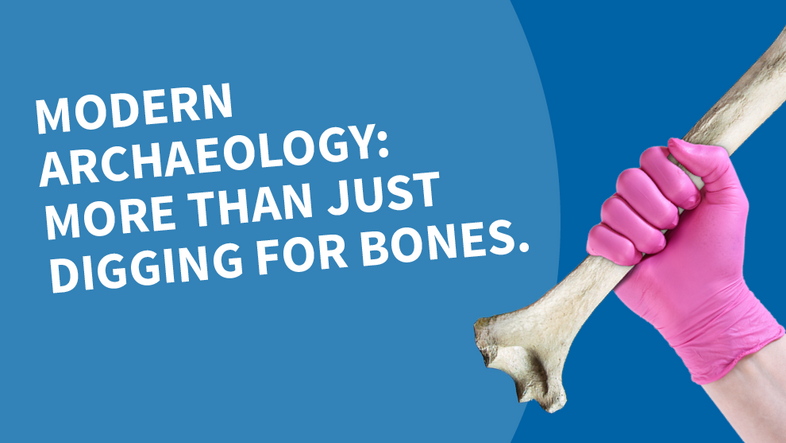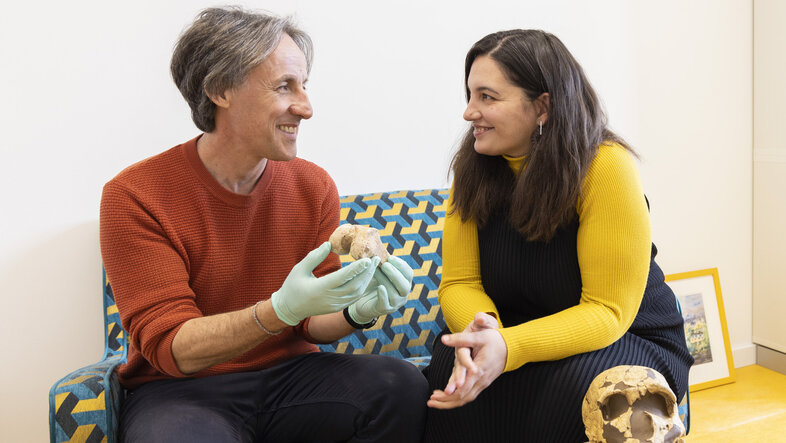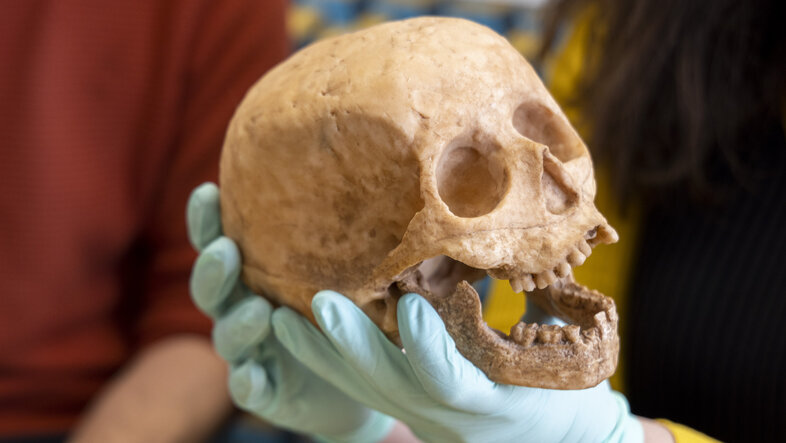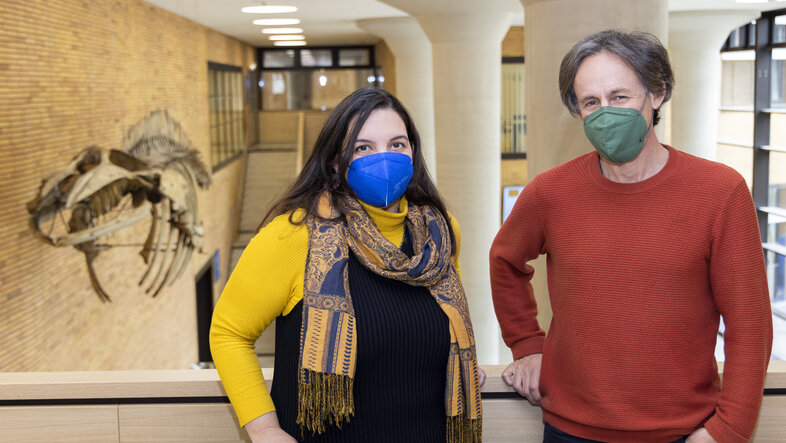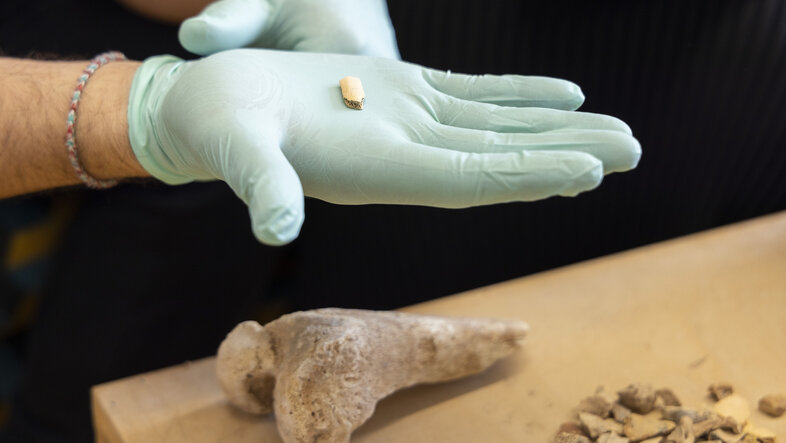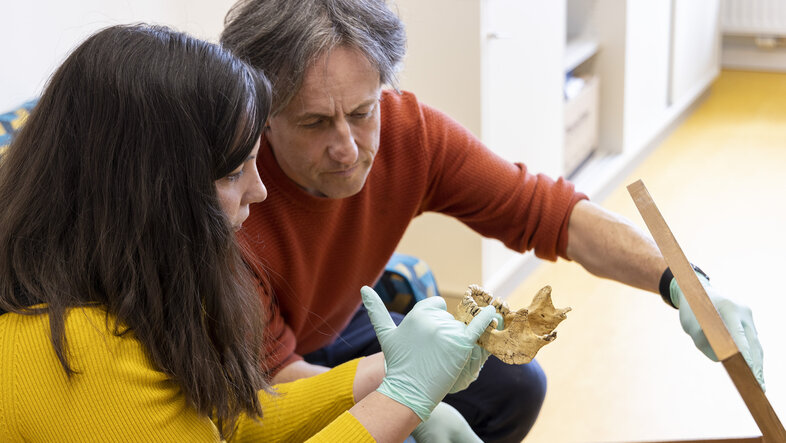What ancient genes tell us about who we are
Our ancient cousins are more present in modern human DNA than we thought: Modern humans possess a small proportion of genes from archaic groups like Neanderthals. Every person having a European or Asian background has an average of two percent of Neanderthal DNA in their blood – for persons having an African background, this number is smaller. This heritage in our genome explains not only some genetic dispositions in modern humans, it is also proof that different human species had contact more than 40,000 years ago.
Homo sapiens: the only species left out of eight or more?
Examining ancient fragments of bone and teeth is the daily business of molecular archaeologists Tom Higham and Katerina Douka. From the trowel to state-of-the-art research equipment such as laser-based mass spectrometers, no archaeological research method is unfamiliar to the two renowned experts on the dating and analysis of prehistoric fossils. The two are a very experienced research team – and a couple – who previously worked at the University of Oxford and the Max Planck Institute for the Science of Human History before joining the University of Vienna in 2021. As we meet them in their brand-new offices at the recently opened University of Vienna Biology Building, the scientists and their team are setting up their labs for their ancient DNA research. While some of the equipment and furniture are still missing, the coffee machine in the kitchenette next door is already running at full speed.
Douka and Higham have worked together with others for the last 15 years to understand more about what happened in the crucial Palaeolithic period, or Old Stone Age. It is likely that there were at least eight different species of humans on Earth (perhaps even more) between 150,000-30,000 years ago – and they sometimes exchanged genetic material through inter-breeding. "Today is a very unusual time in terms of human evolution", while sitting in his office chair Tom Higham explains, "For several million years, we shared the planet with different groups of hominins related to us and now it is just us, as well as our great ape cousins".
Discovery of an ancient human hybrid
A tiny bone that Katerina Douka and Tom Higham analysed from Denisova Cave in Siberia is probably one of their most important discoveries for research on early human history. Katerina Douka explains, "There were fierce debates between groups of researchers over the question of whether different species may have met – and perhaps exchanged ideas and so on. Other scientists did not believe that the species did coexist or even met one another." This situation profoundly changed in 2010 with the publication of the Neanderthal genome, which showed that living people shared some of their DNA. Humans had indeed interbred with Neanderthals.
But how common was this? It seems to have happened more regularly than we thought. "In 2015, we found a tiny human bone fragment using a revolutionary collagen fingerprinting method called ZooMS. Ancient mitochondrial DNA from the bone initially assigned it to a Neanderthal. After fully sequencing it, however, we discovered that it belonged to an estimated 13-year-old girl whose mother was Neanderthal, but whose father was Denisovan. This was the first time anyone has ever found a so-called 'F1 hybrid', a first-generation offspring of two different types of human", explains Katerina Douka.
"Before 2010, such analyses were not possible because the methods did not exist then. We can now take a few milligrams of powder from tiny archaeological bone fragments – and in fact there are bags of bones, tons of them, sitting in storage facilities – and identify the bones to species, thereby finding potential human bone fragments hiding, like this little Denisovan bone. It is quite incredible how methods of examining human remains have improved so dramatically", describes Tom Higham enthusiastically.
Rewriting human history with radiocarbon dating and DNA analysis
Answering other research questions about the origins and behaviour of our ancestors requires different scientific methods. "Nowadays, we use a variety of techniques from different fields: Artificial Intelligence, satellites with laser-based methods to reconstruct three-dimensional surfaces, electron microscopes, CT scanners, particle accelerators and so on", says Tom Higham giving examples of how archaeological science has evolved. "The last 20 years have seen an explosion of the methods we can apply to answer key archaeological questions".
These are exciting times not only for archaeology but also for Douka, Higham and their colleagues at the University of Vienna. They are right at the forefront in the field, developing new methods and approaches and increasing our understanding how early humans lived, interacted and live on in our genes today – and to answering the most fundamental question of all: Where did we come from?
Evolution of human DNA: relevance to today
What relevance does this type of archaeological science have for our world today? "Archaeology is the only method we have to understand the ancient past, before writing and record keeping, so it is really important. It turns out that humans as a whole are extraordinarily closely related to one another and we can see many instances where different groups admixed with one another", says Tom Higham.
Humans often see differences between each other, for example related to skin colour. Archaeology can tell us its history. A human skeleton was found in the British Isles (Cheddar Gorge) in the 1970s, for example, that dated to around 11,000 years ago. DNA analysis and modern technology made it possible to discover what this person had looked like when still alive: He had a darker skin tone and bright blue eyes. This phenotype does not exist today.
"We know that it was also present, however, in other locations in Western Europe. So what happened? The earliest Homo sapiens that entered Eurasia probably had darker skin colour because they were originally living in warmer places", Tom tells us. "The phenotype of lighter skin pigmentation only evolved in the last few thousand years with the arrival of Near Eastern farmers in Europe who possessed two genes necessary for lighter skin tones. We think these grew to high frequency because light skin helps the person to synthesise Vitamin D. Pale skin absorbs ultraviolet radiation more effectively, which is needed in northern latitudes. These data tell us that much recent evolution has taken place and shows how skin colour is really just 'skin deep'."
What is the origin of modern human behaviour?
Tom Higham: Archaeology can tell us a great deal about when modern human behaviour arose, giving insights into the development of cognition and the brain. We see evidence more than 100,000 years ago in Africa, with the discovery of early forms of symbolic art, cursory markings and designs that were made on pieces of mineral ochre, the appearance of early ornaments and jewellery made out of shells and eggshells, animal teeth that were pierced to be worn around the neck, and so on.
Later, we see evidence for deliberate human burials, in which people were laid to rest with objects that they obviously had used in life. Ritual and belief must have been associated with this. Evidence for art works found on cave walls date back at least 45,000 years ago, probably more. Some sites in Eurasia have produced evidence for music in the form of flutes made from swan wing bones and mammoth ivory that date back to 40,000 years ago. They made the same notes that modern instruments can produce.
Read more about "What shapes human behaviour?" (Semester question 2022)
Research at the University of Vienna could solve mystery of human evolution
In future, Tom Higham and Katerina Douka want to find out more about the coexistence of the different human species 50,000 years ago and about what happened to our lost relatives. The first partial question has already been answered: Neanderthals did not die out overnight – the species interbred and their DNA lives on within us to this day, "but like any good research there are other questions that arise from this," says Tom Higham and grins at Katerina Douka: "We think that Vienna will be one of the main centres in the world for this type of work. Looking at the number of people working in this area at the moment – the University of Vienna is one of the real hot spots".
A large bag of bone samples on their desk is awaiting probing with more cutting-edge science designed to solve some of the great mysteries of human origins. The answers might even be hidden in the next tiny bone.
She specialises in radiocarbon dating, in particular the development of new protocols for decontaminating archaeological material, as well as the statistical interpretation of AMS results using Bayesian modelling.
His research areas are: Radiocarbon dating using accelerator mass spectrometry (AMS); Compound-specific radiocarbon sample preparation and pretreatment chemistry; The Middle to Upper Palaeolithic periods of Eurasia, Neanderthals, Denisovans and anatomically modern humans; Archaeological chronologies
